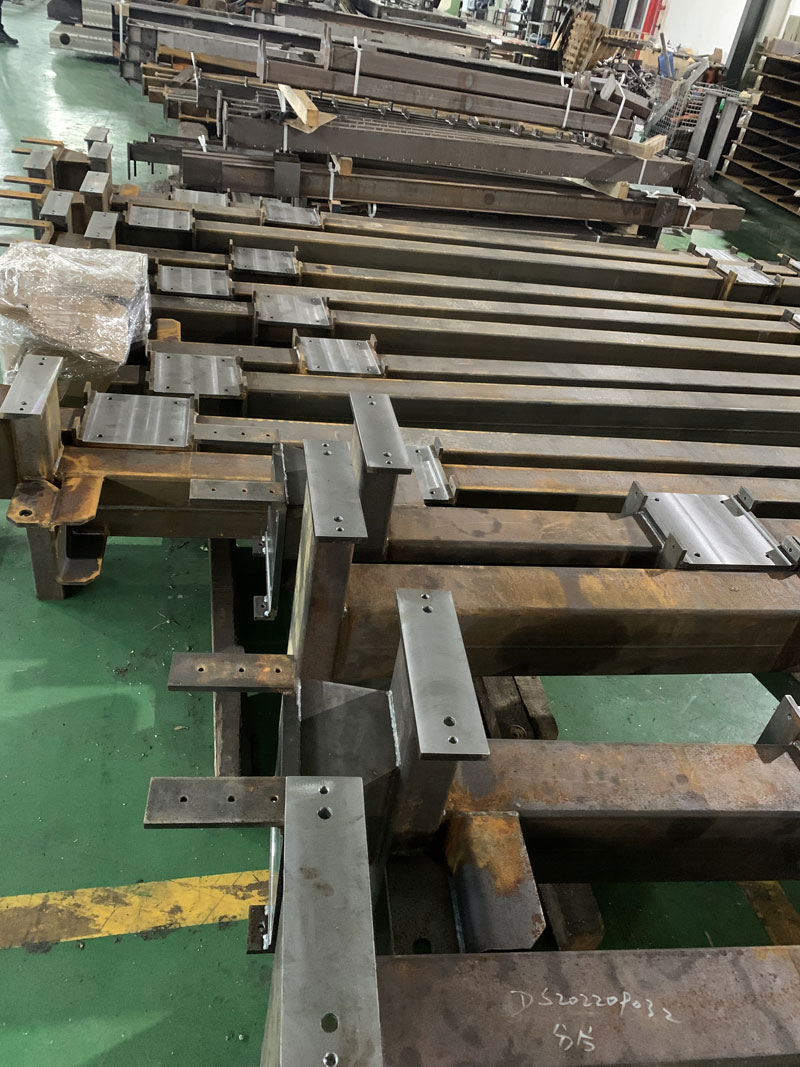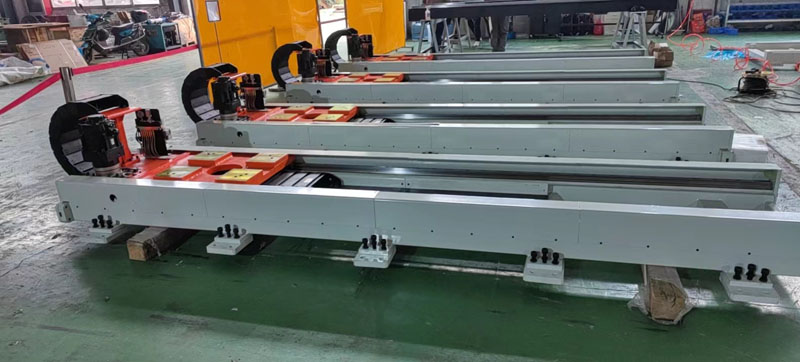First of all, we have to understand what is the guide rail: guide rail is also known as slide rail, linear guide rail, linear slide rail, used in linear reciprocating motion occasions, has a higher rated load than linear bearings, and can bear a certain torque, can achieve high-precision linear movement in the case of high load, efficient and durable, guide rail in our daily life application is also very common, such as sliding door slip, train rails, etc. are the specific application of guide rails. There is also the fact that the guide rail can be used on any machine or equipment that needs to have sliding sliding, such as elevator guide rail, and sometimes it is used on curtains.Let's let Xiaobian take you to see what kinds of guide rails there are:
First, according to the main model of the guide rail can be divided into:
1. Sliding guide rail: sliding guide rail has the advantages of simple structure, convenient manufacturing, good rigidity and high seismic resistance. The disadvantage of traditional cast iron - cast iron, cast iron a quenched steel guide rail is that the static friction coefficient is large, and the dynamic friction coefficient changes with the speed, the friction loss is large, and the crawling phenomenon is easy to occur at low speed, thereby reducing the positioning accuracy of the moving parts, so in addition to the economic CNC machine tool, it has not been used on other CNC machine tools.2. Rolling guide rail: rolling guide rail is to place balls, rollers, needles and other rolling elements between the guide rail surfaces, so that the sliding friction between the guide rail surfaces becomes rolling friction.3. Hydrostatic guide rail: Hydrostatic guide rail can be divided into liquid hydrostatic guide rail and gas hydrostatic guide rail. There is an oil cavity between the working surfaces of the two guide rails of the hydrostatic pressure guide rail, and after the lubricating oil with a certain pressure is introduced, a hydrostatic oil film can be formed, so that the working surface of the guide rail is in pure liquid friction, no wear, and the accuracy is well maintained; At the same time, the friction coefficient is also extremely low, which greatly reduces the driving power; Low speed, no crawling, large bearing capacity, good rigidity; In addition, the oil has vibration absorption and good vibration resistance.Second, according to the nature of the work can be divided into:
Main motion guide: The main movement of the moving rail seat, the relative speed between the guide rail pairs is high.Feed motion guide: The moving guide rail makes feed movement, and the relative movement speed between the guide rail pairs is low.Shift guides: only used to adjust the relative position between components, there is no relative movement during processing, such as the guide rail for the tailstock of lathes.Third, according to the friction properties can be divided into:
Sliding guide rail: The characteristic of sliding guide rail is that the friction between the working surfaces of the guide rail pair is sliding friction.Sliding guides: hybrid friction guides, boundary friction guides, hydrodynamic guides, hydrostatic guides.Rolling friction: There are rolling elements between the working surfaces of the guide rail pair, so that there is rolling friction between the two guide rail surfaces.Rolling guides: ball guides, roller guides, needle roller guides.Fourth, according to the force situation, it can be divided into:
Open rails rely on external loads and component weights to keep the two rail faces fit snugly over their full length.The closed guide rail uses the pressure plate as the auxiliary guide rail surface to ensure that the main rail surface fits the guide rail.5. According to the trajectory of movement, it can be divided into:
Circular motion guide: The relative motion trajectory of the guide rail pair is a circle, such as the flower disc and base guide rail of the vertical lathe.Linear motion guide rail: The relative motion trajectory of the guide rail pair is a straight line. Such as the skateboard and bed guide rail of ordinary lathes.
The guide rails widely used on CNC machine tools are as follows:1. Linear guide railThe new rail system allows the machine to achieve fast feed speeds, which are characteristic of linear guides at the same spindle speed. Linear guides, like planar guides, have two basic elements; One is oriented to the fixed element and the other is the moving element. In order to ensure the accuracy of the machine tool, a small amount of scraping of the bed or column is essential, and in general, the installation is relatively simple.Instead of an intermediate medium between the moving elements and the fixed elements of the linear guides, rolling steel balls are used. Because the rolling steel ball is suitable for high-speed movement, small friction coefficient and high sensitivity, it meets the working requirements of moving parts, such as tool holders and drag plates of machine tools.After a long working time, the steel ball begins to wear, and the pre-load acting on the steel ball begins to weaken, resulting in a decrease in the motion accuracy of the working parts of the machine tool. If the initial accuracy is to be maintained, the rail bracket must be replaced, or even replaced. If the rail system is already pre-loaded. System accuracy has been lost, and the only way is to replace the rolling elements.2. Linear roller guideThe linear roller guide system is a combination of plane guide rail and linear roller guide rail, which is installed on the parallel guide rail with rollers, and the moving parts of the machine tool are carried by rollers instead of steel balls. The advantages are large contact area, large load-bearing load and high sensitivity. From the rear of the bed, the bracket and roller are placed on the top and side of the plane guide, in order to obtain high accuracy, a wedge plate is set between the working parts of the machine tool and the inner surface of the bracket, so that the pre-loaded load acts on the side of the bracket. The principle of operation of the wedge plate is similar to that of an inclined iron, and the weight of the working parts acts on the top surface of the bracket. Since the preload acting on the guide rail system is adjustable, the loss of the wedge plate is compensated, this feature is widely used in medium or large machine tools, because it is sensitive to CNC commands, bears a large load, linear roller guide system can withstand high-speed operation than traditional flat guide machines, improving the performance of the machine tool.3. Inlaid steel guide railThe most commonly used form of guide rail on machine tools is the inlaid steel guide, which has a long history of use. Steel-mounted rails are fixed elements of rail systems with rectangular cross-sections. It can be mounted horizontally on the bed of the machine or cast as one piece with the bed and is called steel inlaid or monolithic. Steel-mounted rails are made of steel, hardened and ground. With a hardness of 60 degrees or more than Rockwell, screws or binders (epoxy) are attached to the machine bed or scraped column mating surface to ensure the best flatness of the guide. This form, maintenance and replacement is convenient and simple, very popular with maintenance workers.4. Sliding guide railThe development of traditional guide rails, first of all, is manifested in the form of sliding elements and guide rails, which are characterized by the use of media between the guide rail and the sliding parts, and the difference in form lies in the selection of different media.Hydraulics are widely used in many rail systems. Hydrostatic guide rail is one of them, hydraulic oil under pressure, into the groove of the sliding element, the formation of oil film between the guide rail and the sliding element, the guide rail and the moving element separated, so as to greatly reduce the friction of the moving element. Hydrostatic rails are extremely effective for large loads and compensate for eccentric loads. For example, when a large sand box is processed, just at the end of the machine stroke, the load guide can increase the oil pressure, so that the guide rail accurately maintains the horizontal load state. Some horizontal boring and milling machines use this technology to compensate for the drop in spindle speed during deep hole machining.Another form of guide rail that uses oil as a medium is the dynamic pressure guide rail, the difference between the dynamic pressure guide rail and the static pressure guide rail is: the oil does not work under pressure, it uses the viscosity of the oil to avoid direct contact between the moving element and the guide rail, and the advantage is to save the hydraulic oil pump.Air can also be used to move the medium between the elements and the guide, it also comes in two forms, aerostatic guide rail and aerodynamic guide rail, the working principle is the same as hydraulic guide rail.5. Other forms of guide railsAnother form of guide rail commonly used on machine tools is dovetail groove guides, which are generally used for the positioning of moving parts of machine tools. For example, the tailstock of the turning center, the guide rail system can make the tailstock move on it or move to the required position to support the machined part, and then quickly clamp. Many accessories of the machine, such as positioning tables, rotary tables or rotary axes, also use dovetail groove guides as positioning elements. It is then clamped in the required position. If the reciprocating stroke of the machine tool is long, V-shaped guide soft, such as surface grinding machines and planers, is used. The advantage is that the V-rail system has good guidance and can withstand gravity cutting. Some adopt the form of a combination of V-shaped guide rail and plane guide rail, V-shaped guide rail as a guide, and plane guide rail as a supporting body.We can also design and manufacture suitable automation products according to the working conditions, processes and requirements of users to meet the various needs of customers and realize intelligent factories. Over the years, we have penetrated into different industries, and our products involve home appliances, automobiles, new energy batteries, motorcycles, rail transit, electrical, petrochemical and other fields. Welcome to inquire about purchasing.